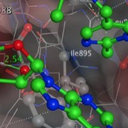Identification of two bromocresol purple binding sites on human serum albumin.
Keywords
Abstract
BACKGROUND
In clinical settings, human serum albumin (HSA) is widely quantitated on the basis of change in the color of bromocresol purple (BCP) bound to HSA. However, the binding sites of BCP on HSA are hitherto unknown. We have identified these sites by performing binding experiments in which BCP was bound to HSA complexed with warfarin, ibuprofen, propofol, or myristic acid.
METHODS
The binding experiment was performed with HSA complexed with a drug in buffers at pH 4.8 and 7.2. The number of BCP binding sites (n) and the association constant (Ka) were obtained by Scatchard analysis using the absorbance data of the BCP-HSA complexes.
RESULTS
Two BCP binding sites on native HSA were identified at pH 7.2 and 1.3 sites were identified at pH 4.8. The number of sites for warfarin-HSA binding was approximately half that of native HSA at both pH values. The site numbers for myristate- and ibuprofen-HSA were 0.3 and 0.8 at pH 7.2, and 1.5 and 2.0 at pH 4.8, respectively; their Ka values were also high (18 x 10(4) and 10 x 10(4)). The Ka values for all HSA samples, except for the 2 samples, arranged from 1.5 x 10(4) to 3.3 x 10(4). The n and Ka values for propofol were equivalent to those for native HSA.
CONCLUSIONS
We postulate that the 2 BCP binding sites include a warfarin-binding site (drug-binding site 1) and 1 of the 2 ibuprofen-binding sites.


